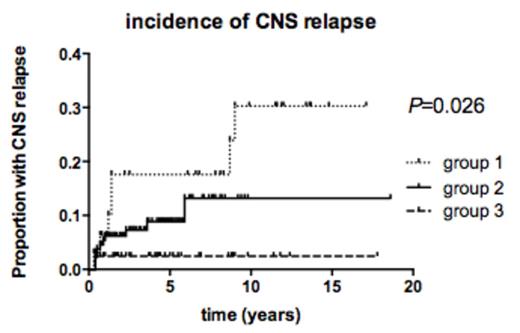Abstract

CNS relapse in DLBCL is a devastating complication and the optimum strategy for prevention remains unclear.
We performed a multi-centre, retrospective analysis of CNS relapse rates in patients (pts) identified at risk of CNS relapse according to the type of CNS-directed prophylaxis administered. Pts receiving initial therapy for DLBCL between 1996 and 2011 (to allow ≥2 years of follow up) were included; DLBCL after histologic transformation of low-grade lymphoma and HIV-associated DLBCL were included, however pts with Burkitt or Burkitt-like lymphoma or CNS involvement at diagnosis were excluded. Selection for CNS prophylaxis strategy was by the primary managing hematologist if they fulfilled ≥2 of the following criteria: 1) multiple extranodal sites 2) raised serum LDH 3) B-symptoms, OR involvement of specific high-risk anatomical sites. We compared 3 prophylaxis strategies: prior to 2003 intrathecal (IT) methotrexate (MTX) in conjunction with CHOP chemotherapy “group 1” was the main strategy; from 2003 onwards, R-CHOP (mostly) with IT MTX was followed by two cycles of high dose intravenous (IV) MTX (1-3g/m2) “group 2”; patients<65 years of age with age adjusted IPI of ≥2 were treated with dose intensive therapy containing high-dose anti-metabolites (Hyper-CVAD or CODOXM-IVAC, with rituximab after it became available) which included both IT and IV MTX “group 3”.
Overall, 208 pts were identified, with 32, 134 and 42 in groups 1, 2 and 3 respectively. Markedly fewer pts in group 1 received rituximab and pts selected for intensive approaches (group 3) were younger, had higher risk disease features (higher serum LDH ratio, more extranodal sites and more B-symptoms) and received fewer doses of IT chemotherapy. The distribution of extranodal sites for each of the three groups was similar, except for epidural/paraspinal disease which was more frequent in group 1 (18%, 5%, 0% in groups 1-3 respectively, P=0.004). With a median follow up of 3.7 years (range 0.4 – 18.6) years, 19 CNS relapses occurred (7, 11 and 1 in groups 1-3 respectively). The 3-year actuarial incidence of CNS relapse was 17.6% (3.5 – 32.7%), 7.3% (3.7 – 11.9%) and 2.4% (0 – 7.1%) in groups 1, 2 and 3 respectively (P=0.026). The 3-year event free survival (EFS) was 70% (53 - 86%), 83% (76 – 90%) and 70% (56 – 84%) in Groups 1 – 3, respectively (P=0.15, data not shown). Use of rituximab, presence of paraspinal disease and decade of treatment were not associated with CNS relapse by univariate analysis. However amongst pts receiving IT MTX, there was a trend toward reduction in CNS relapse for pts receiving 4-6 doses of IT MTX compared to 1-3 (P=0.052) and patients receiving their first dose of IT MTX within seven days of diagnosis (P=0.08).
The use of IV MTX and dose-intense chemotherapy was associated with lower incidence of CNS relapse compared with IT chemotherapy alone.
| . | group 1 CHOP + intrathecal MTX . | group 2 R-CHOP-like chemo +high dose intravenous MTX . | group 3 HyperCVAD or CODOXM/IVAC +/- rituximab . |
|---|---|---|---|
| patients | 32 | 134 | 42 |
| Time period | 1992-2003 | 2003 - 2011 | 1991-2011 |
| median age, years (range) | 55 (29-79) | 62 (19-84) yrs | 45 (16-74) yrs |
| male (%) | 22 (68%) | 87 (65%) | 24 (57%) |
| stage III/IV (%) | 21/31 (68%) | 103/132 (82%) | 38 (93%) |
| B symptoms | 10 (32%) | 47 (36%) | 27 (64%) |
| median serum LDH ratio (range) | 1.1 (0.3-5.9) | 1.3 (0.3 – 11.4) | 1.7 (0.8 – 25.7) |
| ECOG PS ≥1 | 17 (55%) | 67 (55%) | 19 (46%) |
| IPI 3-5 | 15 (44%) | 78 (63%) | 26 (65%) |
| extranodal sites ≥2 | 15 (48%) | 45 (51%) | 30 (86%) |
| chemotherapy | CHOP 30 RCHOP 2 | CHOP 2 R-CHOP 122 R-MACOPB 8 | Hyper CVAD 22 R-Hyper CVAD 16 R-CODOXMIVAC 2 CODOXMIVAC 1 |
| rituximab | 2 (6%) | 122 (98%) | 18 (43%) |
| IT methotrexate (any) 4-6 doses 1-3 doses no IT | 32 (100%) 26 (81%) 6 (19%) 0 (0%) | 84/104 (81%) 75 (72%) 9 (9%) 20 (19%) | 28/33 (85%) 21 (64%) 7 (21%) 5 (15%) |
| . | group 1 CHOP + intrathecal MTX . | group 2 R-CHOP-like chemo +high dose intravenous MTX . | group 3 HyperCVAD or CODOXM/IVAC +/- rituximab . |
|---|---|---|---|
| patients | 32 | 134 | 42 |
| Time period | 1992-2003 | 2003 - 2011 | 1991-2011 |
| median age, years (range) | 55 (29-79) | 62 (19-84) yrs | 45 (16-74) yrs |
| male (%) | 22 (68%) | 87 (65%) | 24 (57%) |
| stage III/IV (%) | 21/31 (68%) | 103/132 (82%) | 38 (93%) |
| B symptoms | 10 (32%) | 47 (36%) | 27 (64%) |
| median serum LDH ratio (range) | 1.1 (0.3-5.9) | 1.3 (0.3 – 11.4) | 1.7 (0.8 – 25.7) |
| ECOG PS ≥1 | 17 (55%) | 67 (55%) | 19 (46%) |
| IPI 3-5 | 15 (44%) | 78 (63%) | 26 (65%) |
| extranodal sites ≥2 | 15 (48%) | 45 (51%) | 30 (86%) |
| chemotherapy | CHOP 30 RCHOP 2 | CHOP 2 R-CHOP 122 R-MACOPB 8 | Hyper CVAD 22 R-Hyper CVAD 16 R-CODOXMIVAC 2 CODOXMIVAC 1 |
| rituximab | 2 (6%) | 122 (98%) | 18 (43%) |
| IT methotrexate (any) 4-6 doses 1-3 doses no IT | 32 (100%) 26 (81%) 6 (19%) 0 (0%) | 84/104 (81%) 75 (72%) 9 (9%) 20 (19%) | 28/33 (85%) 21 (64%) 7 (21%) 5 (15%) |
No relevant conflicts of interest to declare.
Author notes
Asterisk with author names denotes non-ASH members.

This icon denotes a clinically relevant abstract


This feature is available to Subscribers Only
Sign In or Create an Account Close Modal